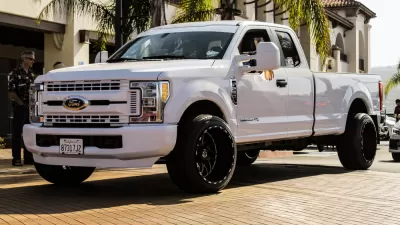Gasoline consumption in the U.S. peaked in 2007, but began climbing in late 2014 with the decline in gas prices. Last year almost set a new record, but increases in gas prices, fuel efficiency and more EVs could reverse the direction—but when?

Due to historically low gas prices and American consumers' preference for sport utility vehicles, gasoline consumption has been increasing for the last three years, though it has yet to surpass the 2007 peak of 9.29 million barrels per day (MMBD).
In October, the Federal Highway Administration reported that the increase in gasoline consumption from January through June of 2016 had increased at a record rate. Some analysts predicted that 2016 would break the 2007 peak.
However, preliminary data released by EIA on January 10 indicates that 2016 gasoline consumption was about 9.28 MMBD, just 10,000 barrels per day shy of the 2007 peak.
But it won't stand for long, as EIA forecasts that consumption will increase to 9.32 MMBD this year, and 9.41 MMBD next year
But Nick Cunningham, energy and environmental issues writer for OilPrice.com, believes consumption will be reduced but to an increase in oil prices stemming from a November OPEC agreement to reduce output that took effect on New Year's Day, and long-term regulatory forces.
"There is no guarantee that U.S. gasoline consumption will continue to expand, however, particularly now that oil prices are on the rise," reports Cunningham on January 5.
According to GasBuddy, American motorists could end up spending an additional $52 billion on gasoline in 2017 compared to last year. GasBuddy estimates gasoline prices will average $2.49 per gallon this year, compared to the 2016 average of just $2.13 per gallon. “It may be years before some of the low prices we saw in 2016 come back,” Patrick DeHaan, Senior Petroleum Analyst at GasBuddy, wrote in a research note.
However, the only certainty in forecasting oil prices is uncertainty. Just four days later, Cunningham reported that oil prices were faltering, followed a week later by "oil prices could fall sharply" due to a production resurgence.
There may be more certainty in the passenger fleet composition, even with Americans' preference for sport and crossover utility vehicles.
"Over the longer-term, consumers will be offered a lot more choices for fuel-efficient and electric vehicles [EVs]," adds Cunningham.
Tesla announced [January 4] that its gigafactory in Nevada has started mass production of lithium-ion batteries hat will be used in its vehicles as well as its home energy storage systems. When production reaches its peak next year, the factory will be producing about as much battery capacity as the rest of the world combined. The added supply will bring down costs, allowing EVs to become more affordable.
Perhaps most intriguing was Ford’s announcement that it would offer an electric-hybrid version of its F-150 truck, the best-selling vehicle in the entire country. It will also release an all-electric SUV with 300 miles of range. Both could be in production by 2020.
According to the University of Michigan's Transportation Research Institute, the "sales-weighted fuel economy" for model years 2014 through 2016 remained stable at 24.1. While sales of electric vehicles (EVs) have increased, they constituted less than one percent of passenger vehicle sales last year. However, an increase in efficiency of light trucks may be enough to reverse the increase in gas consumption, particularly if fuel prices increase as well.
-
2016: Year of the Sports Utility Vehicle, January 10, 2017.
-
U.S. Gasoline Consumption Jumps Three Percent in First Six Months of 2016, November 1, 2016.
FULL STORY: Has U.S. Gasoline Demand Peaked?

Planetizen Federal Action Tracker
A weekly monitor of how Trump’s orders and actions are impacting planners and planning in America.

Map: Where Senate Republicans Want to Sell Your Public Lands
For public land advocates, the Senate Republicans’ proposal to sell millions of acres of public land in the West is “the biggest fight of their careers.”

Restaurant Patios Were a Pandemic Win — Why Were They so Hard to Keep?
Social distancing requirements and changes in travel patterns prompted cities to pilot new uses for street and sidewalk space. Then it got complicated.

California Homeless Arrests, Citations Spike After Ruling
An investigation reveals that anti-homeless actions increased up to 500% after Grants Pass v. Johnson — even in cities claiming no policy change.

Albuquerque Route 66 Motels Become Affordable Housing
A $4 million city fund is incentivizing developers to breathe new life into derelict midcentury motels.

DC Area County Eliminates Bus Fares
Montgomery County joins a growing trend of making transit free.
Urban Design for Planners 1: Software Tools
This six-course series explores essential urban design concepts using open source software and equips planners with the tools they need to participate fully in the urban design process.
Planning for Universal Design
Learn the tools for implementing Universal Design in planning regulations.
Heyer Gruel & Associates PA
JM Goldson LLC
Custer County Colorado
City of Camden Redevelopment Agency
City of Astoria
Transportation Research & Education Center (TREC) at Portland State University
Camden Redevelopment Agency
City of Claremont
Municipality of Princeton (NJ)



























